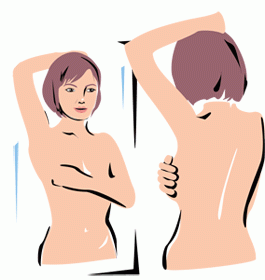 While the most effective way to detect breast cancer is by having a mammogram and a clinical breast exam, adult women of all ages are encouraged to conduct breast self-exams (BSE) at least once a month to become familiar with the look and feel of their breasts so that they can alert their doctor if there are any changes. Finding a breast change does not necessarily mean that it is cancer, but it is important to note unusual changes just in case -- when the cancer is detected in its earlier stages, your chances of surviving the disease are improved.
While the most effective way to detect breast cancer is by having a mammogram and a clinical breast exam, adult women of all ages are encouraged to conduct breast self-exams (BSE) at least once a month to become familiar with the look and feel of their breasts so that they can alert their doctor if there are any changes. Finding a breast change does not necessarily mean that it is cancer, but it is important to note unusual changes just in case -- when the cancer is detected in its earlier stages, your chances of surviving the disease are improved.
There are three ways a breast self-exam can be performed:
In front of a mirror
Stand undressed in front of a mirror. Relax your arms by your sire and look for any changes in the size, position, shape or skin of the breasts. Inspect your skin for any puckering, dimpling, discoloration and examine your nipples for any sores or change in the direction of the nipples. Next, raise your arms high over your head and look for the same symptoms listed above.
In the shower
Raise one arm behind your head to spread out the breast tissue. Using the pads of your fingers from the other hand, press gently and move around your entire breast in circular, up-and-down patterns along the breast, moving from the outside to the center. Check for any lumps or thickening. Repeat on the other side.
Lying Down
Lie down on your back and place a small pillow under your right shoulder and put your right hand behind your head. Place your left hand on the upper part of your right breast with your fingers together. Move the pads of your fingers around your breast in small circular motions to cover the entire breast area using medium pressure. Make sure to feel the out areas that extend into your armpit. Next, check for any changes or discharge in the nipple. Repeat for your left breast.
Changes can include how the breast of nipple feels: nipple tenderness, lump in or near the breast area. A change in the breast or nipple appearance: unexplained change in the size or shape of the breast, unexplained swelling or shrinkage of the breast (especially if on one side only), dimpling on the breast, nipple that is turned inward or is inverted, or skin anywhere on the breast or nipple that becomes scaly and red. Finally, any nipple discharge, particularly clear or bloody discharge.
If you experience or find any of these signs and symptoms, you should make an appointment with your doctor. But don’t worry! Changes in your breasts are natural and normal, but it doesn’t hurt to stay alert!
Check out these breast self-exam guides for diagrams and more information:
US National Library of Medicine
National Breast Cancer Foundation
